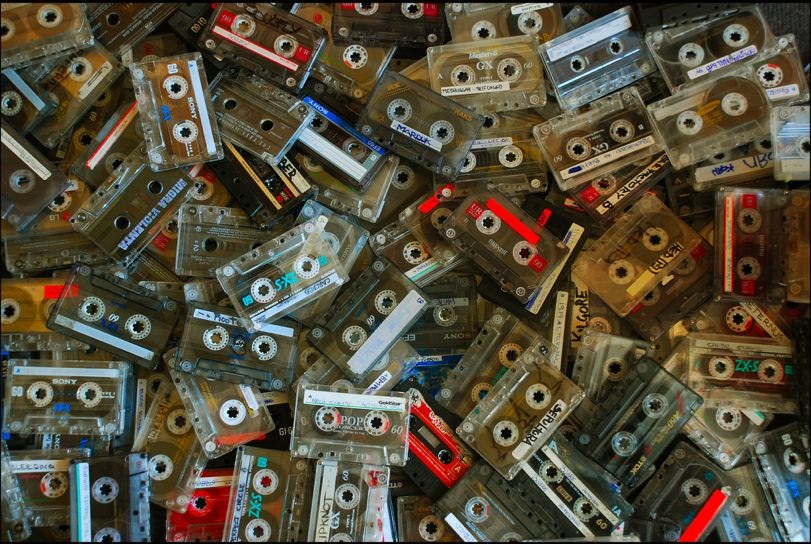I mean to kind of look at why so few women are written about, how that’s recorded and how that all feeds in to a general sense of representational invisibility and this kind of feeling of being slightly marginalised because it’s women but also because of the kind of music that it is, it’s even more marginalised, so it’s like a double thing (transcribed Hedditch SLG-2005).
“Women’s” – and especially lesbian – musical sub-cultures that have faced not only institutional neglect and marginalisation but have also been historically and discursively disqualified from normative musical histories, have by necessity developed what might seem to be unorthodox and grassroots strategies to create, account for and preserve their histories. The music that Emma Hedditch expresses as being “even more marginalised”, which is represented in the Her Noise Archive, is largely the music of the “early nineties girlpunk scene” (transcribed Hedditch SLG-2005). The bands circulating within this scene, such as Bikini Kill, Bratmobile and Le Tigre to name just a few of the most well-known, as Judith Halberstam explains “are most often folded into histories of the ‘riot grrrl’ phenomenon and girl punk,” but that “they must also be placed within a new wave of dyke subcultures” (Halberstam 2005: 154). That Halberstam considers these dyke subcultures as a “new wave” points to the lack of a widely acknowledged historical specificity that this music, as a music specific to lesbian cultures with a legacy that reaches further back into history than the 1990s, has so far received. Terry Castle writing about the historical figure of the lesbian as a “ghostly apparition” explains,
Lesbian contributions to culture have been routinely suppressed or ignored, lesbian-themed works of art censored and destroyed, and would-be apologists – like Radclyffe Hall in the 1920s – silenced and dismissed. Politically speaking, the lesbian is usually treated as a nonperson – without rights or citizenship – or else a sinister bugaboo to be driven from the scene at once” (Castle 1993: 5).
Dyke subcultures then, that have been “routinely suppressed or ignored” and “silenced and dismissed” (ibid) have by necessity developed alternative memorialising and sounding strategies in the face of a continued “representational invisibility” (transcribed Hedditch SLG-2005). Butler exposes this historical silencing of lesbian sexuality and culture as occurring through a specific set of discursive practices that completely disqualify the lesbian as a ‘discursive falsehood’, as an unspeakable speech act, not even an utterance to be silenced (Butler 1993: 312).
To be prohibited explicitly is to occupy a discursive site from which something like a reverse-discourse can be articulated; to be implicitly proscribed is not even to qualify as an object of prohibition (Butler 1993: 312).
“To be prohibited explicitly” requires first a recognisable, articulable identity that is so recognised so as to be denied, a sound that can be silenced. But “to be implicitly proscribed” is not about being erased from discourse – in the sense that yes, you exist but your existence is wrong or forbidden. It is to be inscribed as a discursive falsehood, a ‘nonperson’, not only of “women” from historical music discourses where the words ‘woman’ and ‘composer’ struggle to meet, but specifically in this instance about the unthinkability, ‘unspeakability’ and “representational invisibility” of lesbian identity and culture from hegemonic music as well as wider discourses. In the non-shadow of this ongoing representational invisibility, Anne Cvetkovich, whose scholarship is situated within queer theory and queer archival practices, writes,
Lesbian and gay history demands a radical archive of emotion in order to document intimacy, sexuality, love, and activism – all areas of experience that are difficult to chronicle through the materials of a traditional archive (Cvetkovich 2003: 241).
Cvetkovich’s politicisation of affect – her “radical archive of emotion” – within a social milieu that transforms Oedipal familial structures through wider kinship systems, can be thought to expand upon the critique that Joan Scott levelled toward feminist social history approaches as those that had neglected the “personal and social life – family, sexuality, sociability… areas in which women have been visible participants” (Scott 1999: 24) to focus specifically upon anti-hetereonormatve structures of care, sociality, community. The performance of musical relationships between sociopolitical bodies that occurs through We’re Alive, Let’s Meet! then,– the social patterns, relations and processes – are the compositional and archival materials that Hedditch’s installation materialises through a politicisation of ‘personal’ everyday emotional knowledges. The work performs how it feels – in part as everyday “traces of trauma” (Cvetkovich 2003: 3) – for instance that “feeling of being slightly marginalised” that Hedditch mentions (transcribed Hedditch SLG-2005). And to feel it, is to think it, is to speak it, is to sing and scream and shout it. It is to exist in spaces of erasure.
Cvetkovich’s “radical archive of emotion” (Cvetkovich 2003: 241) proffers a way in which an acknowledgement that “this kind of feeling of being slightly marginalised” is itself a legitimate way for measuring how “so few women are written about and how that’s recorded” (transcribed Hedditch SLG-2005). Affective experience in this installation is the means of recording that erasure that has been historically negated and relegated not only as a ‘hidden life’ but specifically as a ‘non-life’. Thus this ‘feeling’ is both the archival and compositional material whose ephemeral traces can be acknowledged, shared, politicised, depathologised and remixed as an alternative and legitimate form of knowledge production. How it feels to be marginalised, written out of and proscribed from existence becomes the compositional material of the get-togethers of We’re Alive, Let’s Meet!, the substance of the exchange, so as to work through that feeling in a way that can affectively address and re-work the everyday trauma of exclusion through a shared listening as a politics of audition.
